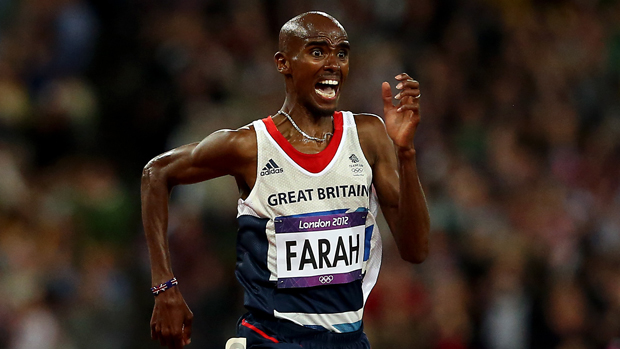Train like an Olympian
Golden advice on how to run faster, jump higher, shoot harder and compete for longer from a host of the world's fittest athletes

Get Higher Off The Ground
Daniel Awde, Team GB 2008 Olympics decathlete and London 2012 medal prospect
“Jumping higher is all about power. In the gym don’t lift too heavy, aim to lift dynamically at about 70 per cent of your one-lift maximum. Good exercises are power lifts, jump squats, cleans and snatches. Over a week I’ll also split decathlon discipline training up, but I’ll always be focused on developing powerful leg muscles that enable me to get off the ground. Combine plyometric box and standing jumps with muscle development drills that include leg presses and extensions. Stretching and flexibility exercises help you too – not only for your legs but for your hips and your spine especially.”
Related article: 4 exercises to help you jump higher
Add Power To Sprints And Shots
Conrad Williams, 4x400m silver medallist in the 2009 World and 2010 European Championships
“Football relies a lot on your quads and hamstrings; they’re key to sprinting. Improve their strength and power by practising using hurdles. Set them out so the first one is the lowest and the second is only a few pigeon steps away. Then make the third, fourth and fifth ones slightly higher and further apart each time. Jump over them to improve the plyometric muscles’ strength in your glutes and quads so you’ll have faster reactions for short sprints around the pitch. If you can jump a hurdle at its full height – 3ft 6in – you’ll be a better jumper when it comes to headers.”
Speed Up Your Footwork To Make A Save
Get FourFourTwo Newsletter
The best features, fun and footballing quizzes, straight to your inbox every week.
Beth Storry, Team GB hockey goalkeeper with over 70 appearances for England and Great Britain
“As a keeper you need to do footwork speed drills using ladders. You begin with one step in each gap, then two steps on your toes in each. Other drills involve quickly stepping in and out of the rungs from right to left and back again. Another key move is ‘setting’. Have someone throw the ball at you from one angle, save it, return it immediately and ‘set’ yourself in time for the second save – aimed from a different angle a fraction of second later. You need to be refocused and sure-footed as quickly as possible after each save.”
Related article: Improve reaction speed and footwork
Spread Yourself To Save A Shot
Bobby White, captain and goalkeeper of the GB Men’s handball team
“One technical aspect that overlaps with football is the ‘spread’ position, favoured by Petr Cech and Wojcech Szcezny and made famous by Peter Schmeichel. It’s a fairly natural technique, making yourself as big as possible while covering the ground and the space above your head to reduce the target area, but you need a strong core, which you can achieve with ‘the plank’. Lie on your front with just your forearms and toes on the floor, keeping your torso rigid and your body in a straight line from ears to toes with no sagging or bending. Hold this position for a series of short sessions building up to 60 seconds.”
Build Up Your Stamina For The Season
Mo Farah, Team GB 5000m world champion and European 10,000m record holder, Olympic 10,000m gold medallist
“The best way to build up stamina is to go for a run every day or every other day (depending on how fit you already are), starting off at a low mileage then gradually making the runs longer and longer. It’s important to not get too carried away and run more than your body can cope with, as it will cause injuries. I run on average 100-120 miles per week to be as fit as possible to race over 5000m and 10,000m. The longer your runs are, the fitter you get. My long runs – around two hours – are what give me the stamina to sustain my pace in 10,000m races.”
Related article: Three drills to help football endurance
Boost Your Lung Power
Jon Schofield, kayaker, former World no.1 in wildwater
“As a sprint kayaker I need strong lungs and high VO2 max. For this we do interval training. Take to the rowing machine and begin in a warm-up mode for 10 minutes, setting the resistance on the machine to a manageable level – say, five – then go up to an intense rowing session for three minutes. Your own fitness levels will dictate how intense this is – for those wearing heart rate monitors, you’d be looking at 80-85 per cent of your maximum heart rate – before slowing down to a light pace for five minutes. Then crank it up again. We’ll do 10 to 14 intervals like this in a session, for three to four sessions a week.”
Chase Down Your Opponent
Marlon Devonish, Team GB 100m and 200m sprinter, 4x100m relay gold medallist in the 2004 Olympics
“It’s not just the work you do on the track or pitch that makes you move faster. I’ve lifted my running to another level by actively training my fast-twitch muscles with explosive weights work. At the gym you should concentrate on speed and technique exercises such as the Olympic power clean and the Olympic snatch. The clean and jerk requires a combination of speed, strength and skill. You start with an unweighted bar, concentrating on correct form, and work up to a weight that’s 30 per cent of your one rep max (the most you can lift in one go). When doing explosive drills remember to do them quickly but technically correct. I have a saying: ‘Don’t just do something – do it with purpose.’ Warm up thoroughly, then perform five sets of five reps, breaking for two minutes between sets.”
Related article: Power boosting gym workout
Conrad Williams is a Mitchum-sponsored UKA athlete: the Mitchum anti-perspirant and deodorant range for men and women is available nationwide (www.mitchum.co.uk). Mo Farah is hosting ‘A Night of Champions’ on September 1 with VIPs including Kolo Toure attending. For more information visit www.mofarahfoundation.org.uk.
